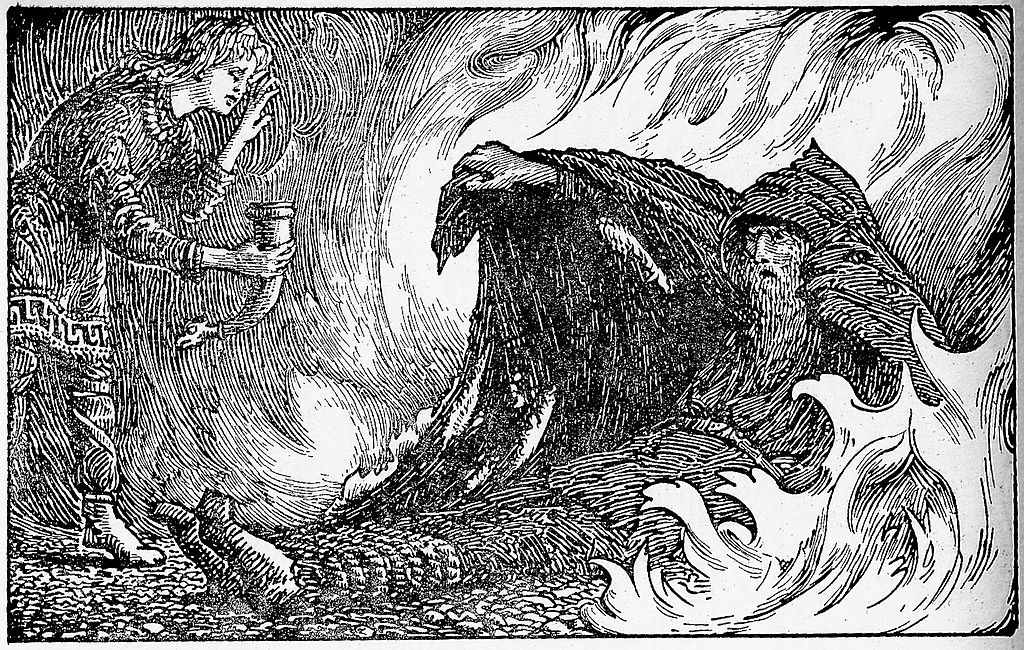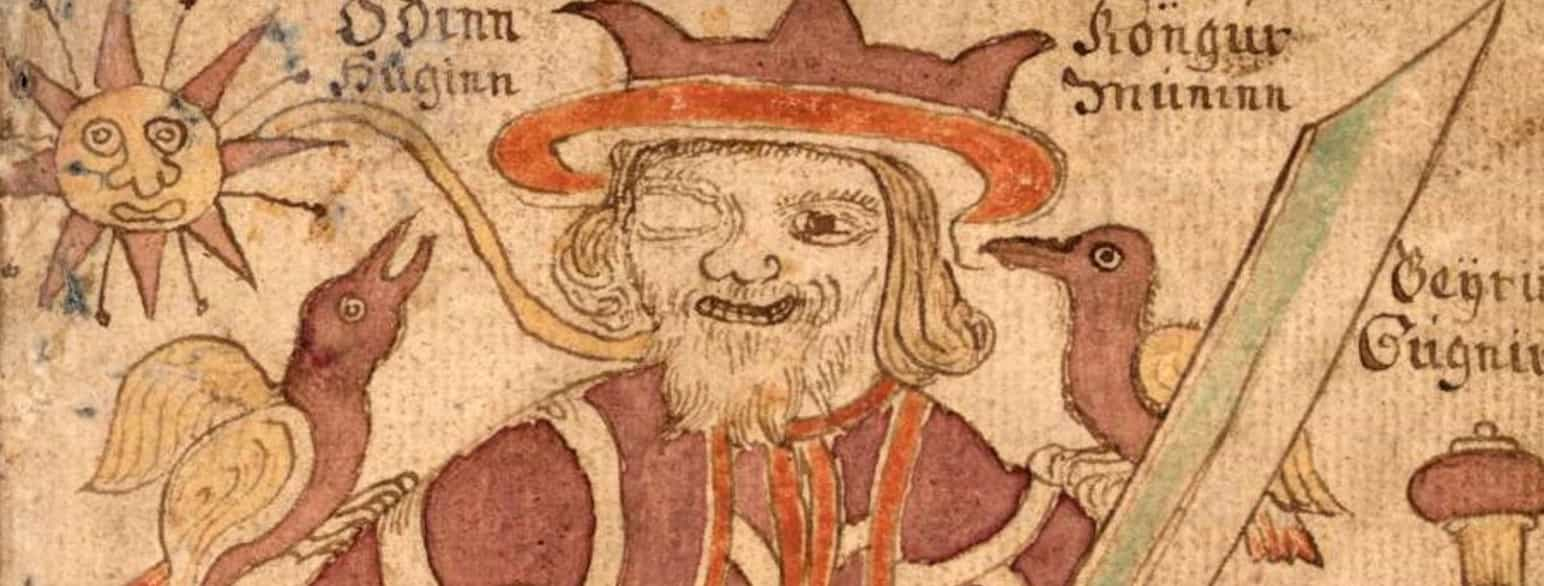Symbols are particularly significant in Nordic mythology. They formed an everyday accompaniment to Viking life, appearing on clothing, furniture, weapons, and armor. One of the best-known is the image of the three interlocking drinking horns, known as the horn Triskelion or the triple horn of the god Odin, the All-Father.
What Do the Horns of Odin Mean?
Horn drinking vessels were essential to traditional Norse toasting rituals and strongly connected with myths and legends about Odin.
Some academics have postulated that the Odin symbol of interlinking horns symbolized the close relationships of Norse Vikings cultivated by their social gatherings, with or without their most-important god.
Apart from being a god of war, poets, and magic, Odin was also a Norse god of alcohol.
In this stanza of poetry from the Grímnismál contained within the Poetic Edda, it insinuated that he only drank wine:
Gera ok Freka
seðr gunntamiðr
hróðigr Herjaföður
en við vín eitt
vopngöfugr
Óðinn æ lifir Grímnismál
The second half of this verse translates roughly as: “But on wine alone doth the weapon-glorious god, Othin, forever live.”
However, knowing how obsessed Odin was with wisdom – he even sacrificed an eye to obtain knowledge from the jötunn Mímir – he would surely have partaken of Odhroerir (Old Norse: Óðrerir), the magical mead of poetry and bestower of sagacity, as well.

The Drinking Horn in Norse Mythology Tales
The drinking horn also featured in many tales of Norse mythology. In the Lokrur, an ancient Icelandic mythological rímur cycle, and Snorri Sturluson’s the Prose Edda; the giant Utgard-Loki tricked Thor when he challenged him to a drinking contest.
Thor had to drain a large drinking horn to win the challenge but failed even though the giant allowed him to take three gulps. With each mouthful, he expected the level of the horn to decrease, but only with the last draught did he notice any difference.

However, Thor had noticed that the horn was strangely challenging to lift, and he had difficulty seeing the other end. These suspicions were confirmed when outside the castle, while bidding the god of thunder farewell, Utgard-Loki eventually revealed that he had enchanted the horn.
He had disguised that it was so long it had reached and was filled by the sea – and that Thor had no chance of ever emptying it. The giant admits that Thor had started to empty the sea on his third attempt and that if he ever passed by it, he would see how the water level had dropped.
Thor attempted to kill the giant by swinging Mjölnir at his head, but he and the castle had magically disappeared.
Why Are There Three Horns?
It is widely believed the three interlocking horns or horned triskele commemorate each day Odin spent with the meadkeeper, the jötunn Gunnlod (Old Norse: Gunnlǫð). He seduced her while on his quest for the magical mead of poetry or mead of Suttungr (the giant who had entrusted Gunnlod with its care).
He also took three vast draughts of the mead that he stored in his cheeks as he flew back to Asgard while transformed into an eagle.
This magic mead bestowed the gift of brilliant verse and great wisdom to whoever drank it.
The three horns may also share a connection with the two vats and a cauldron the dwarves Fjalar and Galar used to store the mead. In common with so many Norse legends, inanimate objects had names, and these storage vessels were no different. The vats were called Boðn and Són, and the cauldron Óðrœrir.
Suttungr came into possession of the vessels after the dwarves had offered them in return for their lives. The giant had trapped them on a reef during a low tide, and they faced death by drowning.
The horn Triskelion may also represent Odin’s love of poetry and wisdom – and the connection of these to Odin himself (the third symbol).
Viking Drinking Out of Horns: The Facts
The original drinking horns date back to the seventh century but were not exclusive to the Viking age. In addition, there are relics of drinking horns found in Greek, Roman, and Celtic ruins.
Viking drinking horns were usually made from ox horn and could be very precious items. They were often hand-carved with significant Viking symbols and featured adornments with precious metals.
The images and runic symbols from the Elder Futhark alphabet often reflected tales and legends of the gods, although some featured symbols and runes of a more personal nature, like a family history or local events. They were often left as heirlooms and passed on from generation to generation.
Commonly-seen images on drinking horns included the binding of Fenrir, Yggdrasil, and Odin’s ravens, Muninn and Huginn.
The Valknut
The Valknut, a trio of interlocking triangles, was also an extremely popular symbol for drinking vessels. This symbol connects warriors and death and may represent the relationship between hell, heaven, and earth.
Hilda Davidson believes there to be a connection between the Valknut, Odin, and the Triskelion.
Alcohol in Norse Culture
Alcohol was an integral part of Norse culture, so much so that the Vikings drank more ale than water! Not because they loved it so much but because it had to undergo a boiling process and thus was safer to drink.
The use of alcohol was a firmly established way of sealing treaties, marriage vows, and land deals. It was also a considerable part of the Viking funerary ceremony involving the minni (a toast of remembrance) and the passing round of the Bragarfull, a ceremonial drinking horn.
There were four main types of alcoholic beverages popular among the Old Norse. We have already seen how popular ale was, and we know about the mead and wine, so that leaves syra (or fermented milk).
The first Viking brewers were all female, and they had a preserve on alcohol and stewarding ceremonial drinking until brewing became a lucrative commercial undertaking or as monks joined the profession too, making beer and wine in their monasteries.
Most wines were fermented local fruit such as apples, cherries, plums, and rhubarb. Wine from grapes was available but had to be imported from Germania and Francia and therefore only available to the wealthiest clients.
The English scholar and folklorist, Hilda Roderick Ellis Davidson, wrote the following text in her book Gods and Myths of Northern Europe:
“The drinking of wine, ale, or mead was of ceremonial importance at all feasts, and it seems to have been this which ‘hallowed’ the hall when men met for sacrifice.”
Horn drinking vessels were essential to traditional Norse toasting rituals. Find out the story behind the horns of Odin.

